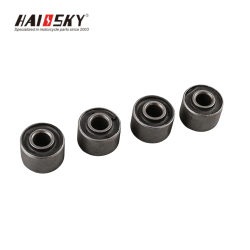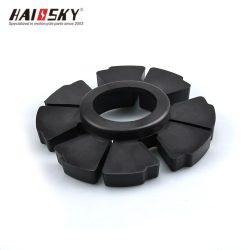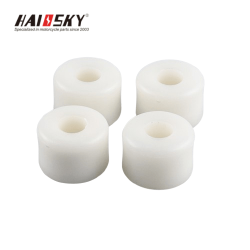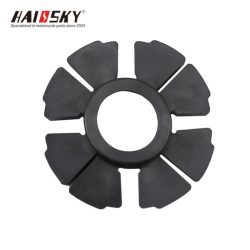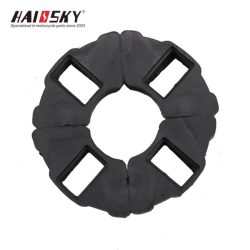OEM Motorcycle Parts
Category: Motorcycle Cushion Rubbers - Drive Chain Dampers
About Motorcycle Cushion Rubber
Motorcycle cushion rubber is a critical component of a motorcycle’s seating system, designed to provide comfort, durability, and vibration absorption. It acts as a buffer between the seat and the motorcycle frame, ensuring a smoother ride by reducing the impact of bumps and road vibrations. Whether you’re a wholesaler, mechanic, or rider, understanding the role and types of motorcycle cushion rubber can help you make informed decisions for better performance and comfort.
Types of Motorcycle Cushion Rubber
Motorcycle cushion rubber comes in various types, each tailored to specific needs and riding conditions. Here are the most common types:
1. Standard Cushion Rubber
This is the most commonly used type, found in most motorcycles. It provides basic comfort and vibration absorption, making it suitable for everyday riding. Standard cushion rubber is typically made from durable synthetic rubber compounds.
2. High-Density Cushion Rubber
Designed for heavy-duty use, high-density cushion rubber offers enhanced durability and support. It is ideal for riders who carry heavy loads or frequently ride on rough terrains. The denser material ensures long-lasting performance under stress.
3. Vibration-Dampening Cushion Rubber
This type is specifically engineered to reduce vibrations from the engine and road. It is often used in high-performance motorcycles to improve ride quality and reduce rider fatigue. Vibration-dampening cushion rubber is made from specialized rubber compounds that absorb and dissipate vibrations effectively.
4. Heat-Resistant Cushion Rubber
For motorcycles that generate significant heat, such as sport bikes or touring models, heat-resistant cushion rubber is essential. It can withstand high temperatures without degrading, ensuring consistent performance and comfort.
5. Custom-Molded Cushion Rubber
Custom-molded cushion rubber is designed to fit specific motorcycle models. It offers a perfect fit and optimal performance, making it a popular choice for riders who want a tailored solution.
Materials Used in Motorcycle Cushion Rubber
The material used in motorcycle cushion rubber plays a significant role in its performance and durability. Here are the most common materials:
Natural Rubber: Known for its elasticity and comfort, natural rubber is often used in premium cushion rubber. It provides excellent vibration absorption but may degrade faster under extreme conditions.
Synthetic Rubber: Synthetic rubber compounds, such as EPDM and SBR, are widely used due to their durability, resistance to weathering, and cost-effectiveness.
Silicone Rubber: Silicone rubber offers superior heat resistance and flexibility, making it ideal for high-performance motorcycles. It is also resistant to UV rays and ozone, ensuring long-lasting performance.
Polyurethane (PU): PU cushion rubber is lightweight, durable, and resistant to abrasion. It is often used in custom-molded cushion rubber for its versatility and comfort.
Specifications and Maintenance of Motorcycle Cushion Rubber
Specifications
Thickness: Typically ranges from 5 mm to 15 mm, depending on the application and motorcycle model.
Density: Measured in kg/m³, density affects the cushion’s support and durability. High-density cushion rubber is heavier but offers better support.
Hardness: Measured on the Shore A scale, hardness determines the cushion’s firmness. Softer cushion rubber provides more comfort, while harder rubber offers better durability.
Maintenance Tips
Regular Inspection: Check the cushion rubber for signs of wear, cracks, or degradation. Replace it if any damage is detected.
Cleaning: Clean the cushion rubber regularly with mild soap and water to remove dirt and debris. Avoid using harsh chemicals that can degrade the material.
Lubrication: Apply a silicone-based lubricant to the cushion rubber to maintain its flexibility and prevent drying out.
Protection: Use a seat cover to protect the cushion rubber from UV rays, moisture, and abrasion.
Replacement: Replace the cushion rubber every 2-3 years or sooner if it shows signs of wear. Using worn-out cushion rubber can compromise ride comfort and safety.
How to Choose the Right Motorcycle Cushion Rubber
Selecting the right cushion rubber for your motorcycle depends on several factors:
Motorcycle Type: Consider the type of motorcycle and its intended use. Sport bikes, cruisers, and off-road motorcycles have different cushion rubber requirements.
Riding Conditions: If you frequently ride on rough terrains or carry heavy loads, opt for high-density or vibration-dampening cushion rubber.
Material: Choose a material that suits your needs and budget. Synthetic rubber is cost-effective, while silicone rubber offers premium performance.
Fitment: Ensure the cushion rubber is compatible with your motorcycle’s make and model. Custom-molded cushion rubber provides the best fit and performance.
Budget: High-quality cushion rubber may cost more but offers better durability and comfort.
How to DIY and Replace Motorcycle Cushion Rubber
Replacing motorcycle cushion rubber is a straightforward process that can be done at home with the right tools and skills. Here’s a step-by-step guide:
Tools Needed:
Screwdriver
Wrench
Cleaning cloth
Silicone lubricant
Replacement cushion rubber
Steps:
Preparation: Park the motorcycle on a flat surface and ensure it is stable. Gather all necessary tools and the replacement cushion rubber.
Remove the Seat: Use a screwdriver or wrench to loosen the bolts or screws holding the seat in place. Carefully remove the seat from the motorcycle.
Inspect the Cushion Rubber: Check the existing cushion rubber for signs of wear or damage. Clean the area around the cushion rubber to remove dirt and debris.
Remove the Old Cushion Rubber: Carefully detach the old cushion rubber from the seat or frame. Use a screwdriver or pliers if necessary.
Install the New Cushion Rubber: Position the new cushion rubber in place and secure it with bolts or screws. Ensure it is properly aligned and fits snugly.
Reattach the Seat: Place the seat back onto the motorcycle and tighten the bolts or screws. Test the seat to ensure it is secure and comfortable.
Lubricate: Apply a silicone-based lubricant to the cushion rubber to maintain its flexibility and prevent drying out.
Frequently Asked Questions (FAQ)
Q: What is the best material for motorcycle seat cushions?
A: The best material depends on your needs. Natural rubber offers excellent comfort, while synthetic rubber is durable and cost-effective. Silicone rubber is ideal for high-performance motorcycles due to its heat resistance.
Q: How can I make my motorcycle seat more comfortable?
A: Use a high-quality cushion rubber, add a gel or memory foam seat pad, and ensure the seat is properly adjusted for your riding position.
Q: Are motorcycle seat cushions worth it?
A: Yes, motorcycle seat cushions significantly improve ride comfort, reduce fatigue, and protect the seat from wear and tear.
Q: How much does it cost to reupholster a motorcycle seat?
A: The cost varies depending on the materials and labor. On average, reupholstering a motorcycle seat can cost between
100
a
n
d
100and300.
Q: What is the best thickness for seat cushion rubber?
A: The ideal thickness depends on your riding style and preferences. Generally, a thickness of 10 mm to 15 mm provides a good balance of comfort and support.
Q: Which is better, latex or memory foam seat cushions?
A: Memory foam offers better pressure relief and conforms to your body shape, making it more comfortable for long rides. Latex is durable and resilient but may not provide the same level of comfort.
By understanding the importance of motorcycle cushion rubber, you can enhance ride comfort, durability, and performance. At Haissky.com, we offer a wide range of high-quality cushion rubber options designed to meet the needs of every rider. Explore our collection today and ensure your motorcycle’s seating system is in top condition!


